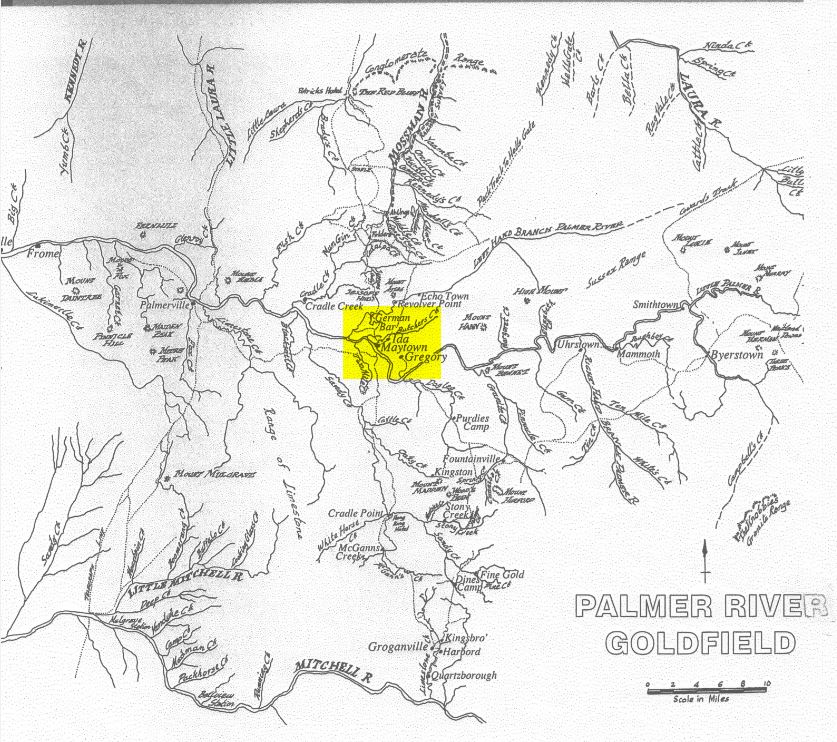R.I.P. Sam Foo
A few weeks after the discovery of gold in north Queensland in 1873, Chinese began arriving from the played-out Victorian goldfields. New Chinese immigrants arrived at the port of Cooktown at a rate of one thousand a month, most from the Pearl River region of Canton. By the end of 1874, almost one-half the population of Palmer River, inland from Cooktown, was Chinese; by 1875 the Chinese population of Palmer River swelled to more than 15,000; by 1877 Chinese outnumbered other nationalities 10:1.
My husband’s ancestor was among those 15,000 Chinese. Sam Foo, a Cantonese, left home, family and friends – everything familiar – for life in far distant Australia. He landed at Melbourne in 1874, age 19, presumably unable to speak or write English, a stand-out with his Oriental features and apparel, to make a new life for himself. Whether by accident or design, he ended up at Palmer River, site of one of the biggest gold rushes in Australia’s history. How he got there from Melbourne is a mystery – there is no record of him on any coastal steamer to Rockhampton or Cooktown. The records seem to indicate that Sam made his way north in stages; he stayed for a year in Copperfield (present-day Clermont) before heading north to Maytown on the Palmer River, the hub of gold mining activity in the far north.
 |
| from “Cooktown – Palmer: north Queensland’s deserted towns”, Colin Hooper, 2007; John Oxley Library, accessed 22 October 2011 |
By the time he arrived on the gold field, the Queensland government, in an effort to stem the tide of Asian immigration, had levied a head tax of £30 on Chinese prospectors, followed by legislation that excluded Chinese from digging on any new gold mine, forcing Chinese prospectors to compete for a chance to work previously abandoned mine sites. Fever, disease and starvation were constant threats in the unfamiliar territory of far North Queensland; an accidental fall from a horse or a native spear in the side meant almost certain death in isolated Palmer River. Sam decided on a better way to make a crust: he paid 8 shillings for a trading licence and created a job for himself – hotelkeeper in the middle of nowhere with a built-in consumer group of very thirsty hard-working miners.
Within a few short years, the gold played out. Sam was amongst many Chinese intent on remaining in Australia, while the wider Australian community regarded with suspicion the numbers of Chinese infiltrating into towns and cities from Palmer River. During the decade 1871-81, Chinese immigration peaked and the level of racist sentiment kept pace; a popular Queensland weekly published a cartoon depicting Chinese as insects; the caption reads “White Man: It’s these pesky locusts that are eating me out of house and home. I must exterminate them somehow”, suggesting a level of bigotry bordering on panic. (The Chinese Plague’, Queensland Punch & Figaro, 4 December 1886)
| SLQ Photographic Collections, accession 09688292, neg 108253, accessed 22 Oct 2011 |
New legislative measures were considered to entice these unwanted immigrants to return to China, including monetary inducements and the refusal of Australian citizenship to ‘inferior’ races. But the Chinese were here to stay, and they were ingenious, able to work around the numerous political and social obstacles designed to block their path. In outback towns across Queensland and New South Wales, Chinese market gardeners invented irrigation and transport systems to supply fresh produce even in the driest conditions; they applied themselves to other occupations too – cooking, farming, furniture-making, herbal medicine and fishing. They proved themselves industrious and law-abiding, working in the sugar industry and in building the railways.
Sam made it. He was the town baker in Surat; his bread was transported via the Cobb & Co. Coach to Roma, Yuleba and surrounding homesteads. He was naturalised in 1886, took a wife – a Lancashire lass – and raised four little Australians, one of whom was my mother-in-law Pauline.
‘On ya, Sam.
Geraldine Lee

Comments
R.I.P. Sam Foo — No Comments
HTML tags allowed in your comment: <a href="" title=""> <abbr title=""> <acronym title=""> <b> <blockquote cite=""> <cite> <code> <del datetime=""> <em> <i> <q cite=""> <s> <strike> <strong>